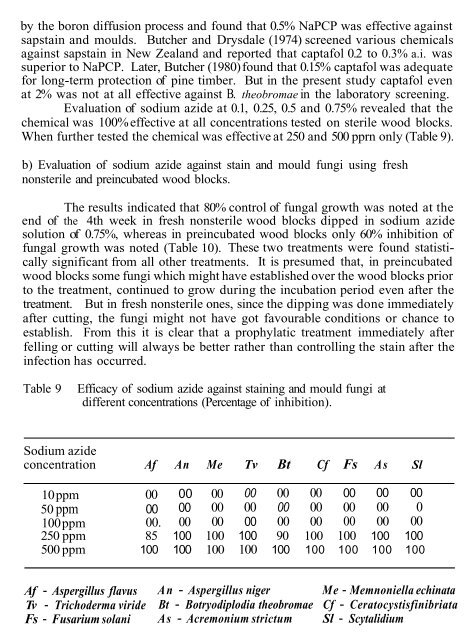sapstain fungi of some commercially important timbers and their ...
sapstain fungi of some commercially important timbers and their ...
sapstain fungi of some commercially important timbers and their ...
You also want an ePaper? Increase the reach of your titles
YUMPU automatically turns print PDFs into web optimized ePapers that Google loves.
y the boron diffusion process <strong>and</strong> found that 0.5% NaPCP was effective against<strong>sapstain</strong> <strong>and</strong> moulds. Butcher <strong>and</strong> Drysdale (1974) screened various chemicalsagainst <strong>sapstain</strong> in New Zeal<strong>and</strong> <strong>and</strong> reported that captafol 0.2 to 0.3% a.i. wassuperior to NaPCP. Later, Butcher (1980) found that 0.15% captafol was adequatefor long-term protection <strong>of</strong> pine timber. But in the present study captafol evenat 2% was not at all effective against B. theobromae in the laboratory screening.Evaluation <strong>of</strong> sodium azide at 0.1, 0.25, 0.5 <strong>and</strong> 0.75% revealed that thechemical was 100% effective at all concentrations tested on sterile wood blocks.When further tested the chemical was effective at 250 <strong>and</strong> 500 pprn only (Table 9).b) Evaluation <strong>of</strong> sodium azide against stain <strong>and</strong> mould <strong>fungi</strong> using freshnonsterile <strong>and</strong> preincubated wood blocks.The results indicated that 80% control <strong>of</strong> fungal growth was noted at theend <strong>of</strong> the 4th week in fresh nonsterile wood blocks dipped in sodium azidesolution <strong>of</strong> 0.75%, whereas in preincubated wood blocks only 60% inhibition <strong>of</strong>fungal growth was noted (Table 10). These two treatments were found statisticallysignificant from all other treatments. It is presumed that, in preincubatedwood blocks <strong>some</strong> <strong>fungi</strong> which might have established over the wood blocks priorto the treatment, continued to grow during the incubation period even after thetreatment. But in fresh nonsterile ones, since the dipping was done immediatelyafter cutting, the <strong>fungi</strong> might not have got favourable conditions or chance toestablish. From this it is clear that a prophylatic treatment immediately afterfelling or cutting will always be better rather than controlling the stain after theinfection has occurred.Table 9Efficacy <strong>of</strong> sodium azide against staining <strong>and</strong> mould <strong>fungi</strong> atdifferent concentrations (Percentage <strong>of</strong> inhibition).Sodium azideconcentration Af An Me Tv Bt Cf Fs As Sl10 ppm 00 00 00 00 00 00 00 00 0050 ppm 00 00 00 00 00 00 00 00 0100 ppm 00. 00 00 00 00 00 00 00 00250 ppm 85 100 100 100 90 100 100 100 100500 ppm 100 100 100 100 100 100 100 100 100Af - Aspergillus flavusTv - Trichoderma virideFs - Fusarium solaniAn - Aspergillus niger Me - Memnoniella echinataBt - Botryodiplodia theobromae Cf - CeratocystisfinibriataAs - Acremonium strictum Sl - Scytalidium lignicola

















